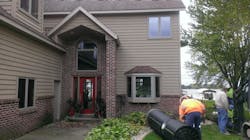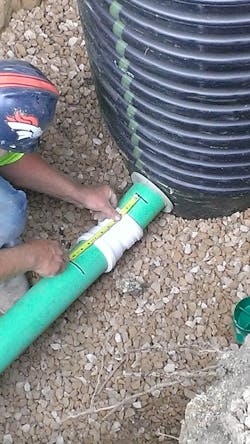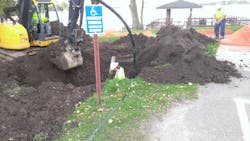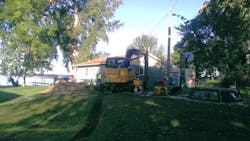A wastewater system with fewer than 800 customers seems eminently manageable. But 732 connections might be unwieldy when the sprawling service area requires a 28-mile trip to drive around it in rural south-central Minnesota. It is comprised of two separate systems built a decade apart which are spread around three lakes with dozens of miles of shoreline, and, remarkably, is maintained by one employee.
Mistakes were made — expensive ones which still surface today — when the Lake Washington Sanitary District (LWSD) low pressure, grinder pump driven All-Terrain Sewer (ATS) went online in 2004. But the LWSD undertook one early, pivotal decision in its septic-to-sewer conversion now paying big dividends. It pioneered the ATS manufacturer’s Sentry Advisor pressure sewer monitoring system which uses telemetry to relay real time performance data from every grinder pump to a utility’s cell phones, tablets and computers.
“Lake Washington was certainly the largest single earlier adopter of Sentry Advisor. They have since been eclipsed by some other large municipal projects, but continue to be a large active user,” said Derek Lachut, director of SSB Engineering at Environment One Corporation (E/One) which developed it and the ATS.
A proactive “efficient ship”
Before talk of artificial intelligence and the evolution of smart sewers became trendy wastewater infrastructure jargon, LWSD wrote in a 2017 newsletter that the Sentry Advisor was, “literally our eyes and ears . . . to view individual flowage of our property owners, run (performance) reports and identify potential problems or concerns” by sending alert notifications advising of high flows, broken pipes, or pump service, all easily locatable with GPS mapping.
“How do we keep this (system) affordable? We run a very efficient ship,” said LWSD chairperson Bob Schmillen. “One guy runs the whole system and does all of the maintenance and others (utilities) have four to five or ten people. We can tell what’s going on at the (customer’s) grinder pump station 24/7.”
Shane Youell, whom LWSD hired in 2016 to oversee maintenance, repairs and billing for 470 pumps on Lake Washington and 262 at Madison Lake and Ballantyne Lake, said that there is not one part of his day that he’s not using and interacting with Sentry Advisor.
“In the simplest terms, I was blind pre-Advisor and now I can see,” said Youell.
A septic-lake cocktail
About one in five of the country’s estimated 115 million occupied homes depend on septic systems. Most states have stringent regulations but inspect only a small fraction of septic systems or have owners who will pump tanks every three-to-five years.
The Minnesota Pollution Control Agency (MPCA) estimates the state has 600,000 homes and businesses whose septic systems generate around 45 billion gallons of wastewater annually, many surrounding its Land of 10,000 Lakes.
“The issues faced by lakeshore communities . . . include small lots, old systems, poor soils, surfacing of sewage in yards, or from individual straight pipes and ‘cheater’ lines off hydraulically overloaded systems,” wrote MPCA. “Many lots cannot accommodate modern septic systems that meet the requirements of current codes due to small lot size and inadequate soils.”
A dozen years later, Short Elliott Hendrickson Inc. (SEH) in nearby Mankato wrote a septic-to-sewer feasibility study for the Madison & Ballantyne Lakes Sub-district (MBLS, now administered by LWSD).
Most properties surrounding the MBLS lakes also relied on septic systems for wastewater treatment. The 2013 feasibility study by SEH found that “existing systems are failing, contributing to the degradation of water quality of the lakes. High groundwater and inadequate lot size do not allow for the construction of a system that meets current regulatory requirements. For some of these properties, wastewater is managed with holding tanks that must be pumped on a regular basis. Considering lot sizes around the lake, the vast majority do not have room for a treatment site or would not have room for a second site when an existing system fails.”
Art Zuhlsdorf, former LWSD treasurer, grew up on the lake in the early 1950s to present. He saw the lake’s water quality move from very clear to very scummy in the summer, with an increase of weed problems.
“The leaching was supposed to stay in the area of the septic system, but out of about 450 properties, around 90% failed testing and were leaching into the lake,” said Zuhlsdorf. “We had probably 10% where there was no septic tank, just a direct run from the cabins into the lakes.”
“We found some rather interesting septic systems, or lack thereof,” Schmillen added. “It’s always a question with septic of if you are overloading it. Is it going to fail? It is going to fail. It’s a question of when.”
Opting for an all-terrain sewer
LWSD was officially recognized by order of the MPCA in 2002, allowing Lake Washington to connect to the wastewater treatment plant (WWTP) about 13 miles away in Mankato. A year earlier it had consulted an engineering firm to prepare a feasibility study.
The gravity system proposal included the construction of 17 lift stations, 50,000 linear feet of force main and 44,000 linear feet of gravity sewer collection system. It was rejected.
“I don’t think they really understood what we wanted and what we needed,” said Schmillen, who was not on the board at the time. “I was told the gravity system would have cost much more and been much more invasive — dewatering, trenching, back hoes, track hoes. The gravity system that they had originally tried to sell us would not work because of the contour of the ground around here. It’s very hilly, we have some low spots that are just above the water line of the lake and some high spots somewhere around 100 to 110 feet above the lake and then the distance that we had to go to connect to a city owned system is about 4.5 miles from our last pumping station which would have been an elevation of about 50 feet above the lake.”
The pump inside a grinder pump station — a tank about the size of a refrigerator that is buried in the ground — creates high head conditions and a robust torque, which can propel wastewater through small-diameter, inflow-and-infiltration-free pressurized pipes for a distance of more than 2 miles or even straight up 186 feet to a force main or treatment plant.
The 1-hp progressing cavity design of the E/One semi-positive displacement pump (SPD) was modeled specifically for pressure sewer applications. With this pump, sewage is moved regardless of how many individual grinder pumps are operating whereas, with centrifugal pumps, too much flow in the line will hit the shut-off head in the pump and the sewage is stagnant until that pressure drops low enough. As a result of that issue, along with reliability records, SPD pumps are increasingly used to replace their centrifugal counterparts.
Because of Minnesota’s harsh winters, the grinder pump is buried beneath the frost line. Grinder pump stations can also have a 2-inch thick insulation disc with an R-5 value which provide an air brake from cold temperatures.
Losing a lawnmower
But when LWSD activated its ATS, a true ordeal began.
“The system was installed incorrectly. Period. End paragraph,” said Schmillen.
“We kind of did everything without knowing what we were doing,” said Zuhlsdorf. “E/One was originally suggested to us through the engineering firm, but the firm had no clue to how it was supposed to be installed. We had E/One people down and they basically trained the engineering firm on the system and trained the contractor that was hired to install the system.”
“The contractor subcontracted a lot and didn’t watch them, so we had a lot of problems with equipment that wasn’t installed properly, and we finally caught up to the point where ... what was going on?” said Zuhlsdorf. “It cost us quite a bit of money to go back and repair everything. One hundred seventy homes we had to go back in and re-do. I’m guessing that we probably paid for a system and a half.”
In one instance, the contractor did not install pipe between the grinder pump and the house.
“Part of the project was to demo and fill in old septic tanks and it wasn’t done properly,” said Zuhlsdorf. “In a couple of cases we had sink holes in the yards.”
In one instance, the ground opened and “a guy lost his lawnmower,” Zuhlsdorf added.
Staying with What Works
In 2008, the city of Madison Lake — about 7 miles from Lake Washington — entered into an agreement with Mankato to construct a regional lift station and force main to connect with Mankato’s collection system. It soon was joined by Ballantyne Lake. LWSD later absorbed the new district.
SEH recommended the MBLS follow Lake Washington with an All-Terrain Sewer.
“After the 2004 experiences they (LWSD) wanted nothing to do with expansion,” said Scott Swenson of Minnesota Pump Works. “Then they became more comfortable with the product. It’s a story of having faith in the product and manufacturer and realizing it was more installation on the first round [which] allowed them to get comfortable with the system and sewer additional lakes.”
The $6.8 million Madison-Ballantyne contract, Swenson added, set different requirements for the project, and wrote in things like E/One training and incorporating E/One UNI-LATERAL assemblies and Sentry Advisor alarm panels.
“From a learning standpoint, when we did the second project we knew what absolutely had to be done,” Schmillen said. “When we took on the project, I insisted that Shane (Youell), who worked for the maintenance contractor, would investigate the system, not the engineers. He had control over everything that went into the ground. He inspected everything. Nothing was to be covered up until we got his approval. We’ve had zero issues, zero.”
Operations & maintenance improvement
The result is two systems — Lake Washington, and the Madison Lake and Ballantyne Lake combination — that are different due to the installation procedures.
“Lake Washington is a system that suffers from extremely poor installation, a true testament to E/One pumps lasting as long as they do despite it,” Youell said, “and we have Madison Lake and Ballantyne Lake, which were installed to specs and a strict inspection checklist.”
Operations and Maintenance (O&M) records for routine use of E/One’s SPD pumps are well-documented at other projects for a decade or longer. The average mean time between service calls is 8 to 10 years. If pumps require service, they can be hoisted from the housing by removing only a few screws from the lid before they are cleaned, diagnosed and serviced by maintenance department employees or a distributor. One operator of SPD pumps marveled that a unit they replaced, “had been in the ground for 28 years and never had any service performed on it.”
“If I had to put a number to it, I would say that 99% of my calls are on Lake Washington,” Youell said. “I think we started out Lake Washington with over 100 calls the first year it went online. To put it into perspective, the first year of Madison and Ballantyne lakes, we had four calls, all four simple, warranty-related with the pump.”
For the four-year period from 2006 through 2009, O&M at Lake Washington averaged approximately $74,500 annually, according to SEH’s 2013 MBLS feasibility study.
A six-year compilation of LWSD work orders — from pump service to glitchy alarms within the panel/board or higher usage investigation — showed that between 2017 and 2022, Lake Washington saw four years with 56 to 68 work orders in each with a high of 91 in 2020 and a low of 39 in 2022. Madison Lake and Ballantyne Lake saw only two to six pump problems annually over the same period, combined.
“I think on Madison and Ballantyne lakes, I’m hoping we’ll see numbers better than the 8 to 10 years. I’m hoping for 12 to 14. I don’t believe that’s an unrealistic number,” Youell said.
In hindsight, Zuhlsdorf said he believed the journey was worth it.
“We don’t have the septic run-off in the lake,” he said. “We have a lot of fertilizers going into it. Lake Washington has been on the system for 16 to 17 years and it’s to the point where the water in the spring is as clear as can be and you could almost drink it.”
SIDEBAR 1
When a half-dozen property owners contested special assessments for the Madison-Ballantyne project, three real estate agents testified in court that most home values would grow approximately $26,000 because, as the court found, "bringing a failing septic system into compliance and cleaning up improper wastewater discharge would increase the value of a property” and that a low pressure sewer would provide a long-term cost-effective solution.
About the Author
Joseph Harmes
Joseph Harmes is an independent writer. Harmes can be reached at [email protected].





